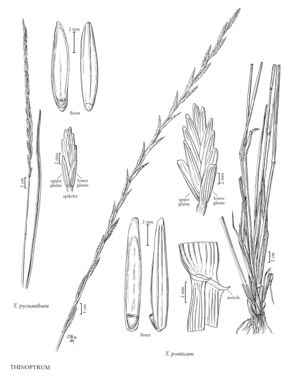Difference between revisions of "Thinopyrum pycnanthum"
FNA>Volume Importer |
imported>Volume Importer |
||
| (8 intermediate revisions by 2 users not shown) | |||
| Line 7: | Line 7: | ||
|synonyms={{Treatment/ID/Synonym | |synonyms={{Treatment/ID/Synonym | ||
|name=Elytrigia pycnantha | |name=Elytrigia pycnantha | ||
| − | |authority= | + | |authority= |
| − | }}{{Treatment/ID/Synonym | + | |rank=species |
| + | }} {{Treatment/ID/Synonym | ||
|name=Elymys pycnanthus | |name=Elymys pycnanthus | ||
| − | |authority= | + | |authority= |
| − | }}{{Treatment/ID/Synonym | + | |rank=species |
| + | }} {{Treatment/ID/Synonym | ||
|name=Agropyron pungens | |name=Agropyron pungens | ||
| − | |authority= | + | |authority= |
| − | }}{{Treatment/ID/Synonym | + | |rank=species |
| + | }} {{Treatment/ID/Synonym | ||
|name=Agropyron littorale | |name=Agropyron littorale | ||
| − | |authority= | + | |authority= |
| + | |rank=species | ||
}} | }} | ||
|hierarchy=Poaceae;Poaceae subfam. Pooideae;Poaceae tribe Triticeae;Thinopyrum;Thinopyrum pycnanthum | |hierarchy=Poaceae;Poaceae subfam. Pooideae;Poaceae tribe Triticeae;Thinopyrum;Thinopyrum pycnanthum | ||
| Line 29: | Line 33: | ||
-->{{Treatment/Body | -->{{Treatment/Body | ||
|distribution=Maine;Mass.;Wash.;Tex.;N.H.;Oreg.;Alta.;N.S.;R.I.;N.Y.;Pa. | |distribution=Maine;Mass.;Wash.;Tex.;N.H.;Oreg.;Alta.;N.S.;R.I.;N.Y.;Pa. | ||
| − | |discussion=<p>Thinopyrum pycnanthum is native to the coasts of western and southern Europe. It is reported from scattered locations in the western United States, and from Nova Scotia to Pennsylvania in eastern North America. In its native range, it grows in maritime sands and gravels, or river gravels.</p> | + | |discussion=<p><i>Thinopyrum pycnanthum</i> is native to the coasts of western and southern Europe. It is reported from scattered locations in the western United States, and from Nova Scotia to Pennsylvania in eastern North America. In its native range, it grows in maritime sands and gravels, or river gravels.</p> |
|tables= | |tables= | ||
|references= | |references= | ||
| Line 38: | Line 42: | ||
-->{{#Taxon: | -->{{#Taxon: | ||
name=Thinopyrum pycnanthum | name=Thinopyrum pycnanthum | ||
| − | |||
|authority=(Godr.) Barkworth | |authority=(Godr.) Barkworth | ||
|rank=species | |rank=species | ||
| Line 45: | Line 48: | ||
|basionyms= | |basionyms= | ||
|family=Poaceae | |family=Poaceae | ||
| + | |illustrator=Cindy Roché;Annaliese Miller | ||
| + | |illustration copyright=Utah State University | ||
|distribution=Maine;Mass.;Wash.;Tex.;N.H.;Oreg.;Alta.;N.S.;R.I.;N.Y.;Pa. | |distribution=Maine;Mass.;Wash.;Tex.;N.H.;Oreg.;Alta.;N.S.;R.I.;N.Y.;Pa. | ||
|reference=None | |reference=None | ||
| Line 50: | Line 55: | ||
|publication year= | |publication year= | ||
|special status= | |special status= | ||
| − | |source xml=https:// | + | |source xml=https://bitbucket.org/aafc-mbb/fna-data-curation/src/200273ad09963decb8fc72550212de541d86569d/coarse_grained_fna_xml/V24/V24_546.xml |
|subfamily=Poaceae subfam. Pooideae | |subfamily=Poaceae subfam. Pooideae | ||
|tribe=Poaceae tribe Triticeae | |tribe=Poaceae tribe Triticeae | ||
Latest revision as of 16:24, 11 May 2021
Plants rhizomatous. Culms 10-120 cm, glabrous; lowest internode plus sheath 2-3 mm thick. Lower sheaths ciliate; auricles absent or to 0.5 mm; ligules 0.3-0.6 mm, truncate, ciliate; blades to 35 cm long, 2-6 mm wide, flat or convolute, glaucous, adaxial surfaces with 3-20 ribs, ribs prominent, crowded, flattened, scabrous. Spikes 4-20 cm; rachises glabrous; internodes 5-9 mm. Spikelets 10-20 mm, with 3-10 florets; disarticulation beneath the florets. Glumes 4.5-8 mm, glabrous, oblong-lanceolate, 4-7-veined, weakly keeled, keels asymmetric, scabridulous, midveins slightly longer and more prominent than the lateral veins, apices acute; lemmas 7-11 mm, glabrous, subobtuse, unawned, mucronate, or awned, awns to 10 mm; paleas keeled, keels ciliate; anthers 5-7 mm. 2n = 42.
Distribution
Maine, Mass., Wash., Tex., N.H., Oreg., Alta., N.S., R.I., N.Y., Pa.
Discussion
Thinopyrum pycnanthum is native to the coasts of western and southern Europe. It is reported from scattered locations in the western United States, and from Nova Scotia to Pennsylvania in eastern North America. In its native range, it grows in maritime sands and gravels, or river gravels.
Selected References
None.
